Kezhi Kong
NVIDIA Nemotron Nano 2: An Accurate and Efficient Hybrid Mamba-Transformer Reasoning Model
Aug 21, 2025



Abstract:We introduce Nemotron-Nano-9B-v2, a hybrid Mamba-Transformer language model designed to increase throughput for reasoning workloads while achieving state-of-the-art accuracy compared to similarly-sized models. Nemotron-Nano-9B-v2 builds on the Nemotron-H architecture, in which the majority of the self-attention layers in the common Transformer architecture are replaced with Mamba-2 layers, to achieve improved inference speed when generating the long thinking traces needed for reasoning. We create Nemotron-Nano-9B-v2 by first pre-training a 12-billion-parameter model (Nemotron-Nano-12B-v2-Base) on 20 trillion tokens using an FP8 training recipe. After aligning Nemotron-Nano-12B-v2-Base, we employ the Minitron strategy to compress and distill the model with the goal of enabling inference on up to 128k tokens on a single NVIDIA A10G GPU (22GiB of memory, bfloat16 precision). Compared to existing similarly-sized models (e.g., Qwen3-8B), we show that Nemotron-Nano-9B-v2 achieves on-par or better accuracy on reasoning benchmarks while achieving up to 6x higher inference throughput in reasoning settings like 8k input and 16k output tokens. We are releasing Nemotron-Nano-9B-v2, Nemotron-Nano12B-v2-Base, and Nemotron-Nano-9B-v2-Base checkpoints along with the majority of our pre- and post-training datasets on Hugging Face.
Llama-Nemotron: Efficient Reasoning Models
May 02, 2025



Abstract:We introduce the Llama-Nemotron series of models, an open family of heterogeneous reasoning models that deliver exceptional reasoning capabilities, inference efficiency, and an open license for enterprise use. The family comes in three sizes -- Nano (8B), Super (49B), and Ultra (253B) -- and performs competitively with state-of-the-art reasoning models such as DeepSeek-R1 while offering superior inference throughput and memory efficiency. In this report, we discuss the training procedure for these models, which entails using neural architecture search from Llama 3 models for accelerated inference, knowledge distillation, and continued pretraining, followed by a reasoning-focused post-training stage consisting of two main parts: supervised fine-tuning and large scale reinforcement learning. Llama-Nemotron models are the first open-source models to support a dynamic reasoning toggle, allowing users to switch between standard chat and reasoning modes during inference. To further support open research and facilitate model development, we provide the following resources: 1. We release the Llama-Nemotron reasoning models -- LN-Nano, LN-Super, and LN-Ultra -- under the commercially permissive NVIDIA Open Model License Agreement. 2. We release the complete post-training dataset: Llama-Nemotron-Post-Training-Dataset. 3. We also release our training codebases: NeMo, NeMo-Aligner, and Megatron-LM.
Nemotron-H: A Family of Accurate and Efficient Hybrid Mamba-Transformer Models
Apr 10, 2025

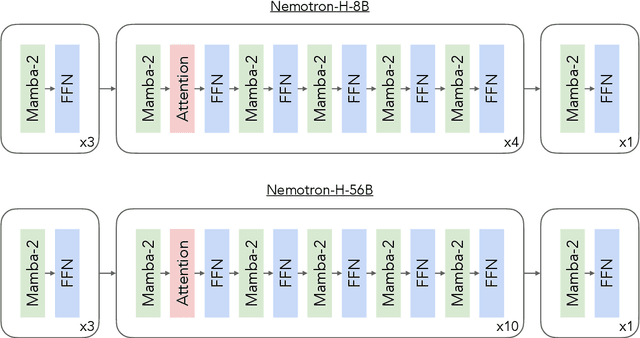
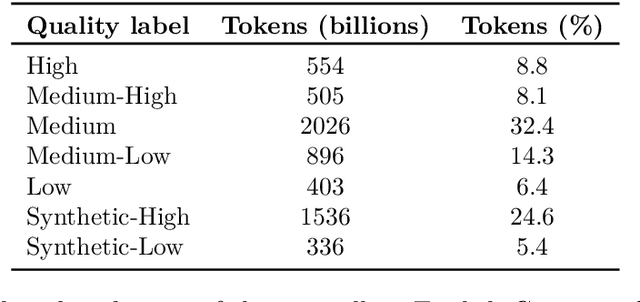
Abstract:As inference-time scaling becomes critical for enhanced reasoning capabilities, it is increasingly becoming important to build models that are efficient to infer. We introduce Nemotron-H, a family of 8B and 56B/47B hybrid Mamba-Transformer models designed to reduce inference cost for a given accuracy level. To achieve this goal, we replace the majority of self-attention layers in the common Transformer model architecture with Mamba layers that perform constant computation and require constant memory per generated token. We show that Nemotron-H models offer either better or on-par accuracy compared to other similarly-sized state-of-the-art open-sourced Transformer models (e.g., Qwen-2.5-7B/72B and Llama-3.1-8B/70B), while being up to 3$\times$ faster at inference. To further increase inference speed and reduce the memory required at inference time, we created Nemotron-H-47B-Base from the 56B model using a new compression via pruning and distillation technique called MiniPuzzle. Nemotron-H-47B-Base achieves similar accuracy to the 56B model, but is 20% faster to infer. In addition, we introduce an FP8-based training recipe and show that it can achieve on par results with BF16-based training. This recipe is used to train the 56B model. All Nemotron-H models will be released, with support in Hugging Face, NeMo, and Megatron-LM.
Maximize Your Data's Potential: Enhancing LLM Accuracy with Two-Phase Pretraining
Dec 18, 2024



Abstract:Pretraining large language models effectively requires strategic data selection, blending and ordering. However, key details about data mixtures especially their scalability to longer token horizons and larger model sizes remain underexplored due to limited disclosure by model developers. To address this, we formalize the concept of two-phase pretraining and conduct an extensive systematic study on how to select and mix data to maximize model accuracies for the two phases. Our findings illustrate that a two-phase approach for pretraining outperforms random data ordering and natural distribution of tokens by 3.4% and 17% on average accuracies. We provide in-depth guidance on crafting optimal blends based on quality of the data source and the number of epochs to be seen. We propose to design blends using downsampled data at a smaller scale of 1T tokens and then demonstrate effective scaling of our approach to larger token horizon of 15T tokens and larger model size of 25B model size. These insights provide a series of steps practitioners can follow to design and scale their data blends.
Nemotron-CC: Transforming Common Crawl into a Refined Long-Horizon Pretraining Dataset
Dec 03, 2024Abstract:Recent English Common Crawl datasets like FineWeb-Edu and DCLM achieved significant benchmark gains via aggressive model-based filtering, but at the cost of removing 90% of data. This limits their suitability for long token horizon training, such as 15T tokens for Llama 3.1. In this paper, we show how to achieve better trade-offs between accuracy and data quantity by a combination of classifier ensembling, synthetic data rephrasing, and reduced reliance on heuristic filters. When training 8B parameter models for 1T tokens, using a high-quality subset of our data improves MMLU by 5.6 over DCLM, demonstrating the efficacy of our methods for boosting accuracies over a relatively short token horizon. Furthermore, our full 6.3T token dataset matches DCLM on MMLU, but contains four times more unique real tokens than DCLM. This unlocks state-of-the-art training over a long token horizon: an 8B parameter model trained for 15T tokens, of which 7.2T came from our dataset, is better than the Llama 3.1 8B model: +5 on MMLU, +3.1 on ARC-Challenge, and +0.5 on average across ten diverse tasks. The dataset is available at https://data.commoncrawl.org/contrib/Nemotron/Nemotron-CC/index.html
OpenTab: Advancing Large Language Models as Open-domain Table Reasoners
Feb 22, 2024



Abstract:Large Language Models (LLMs) trained on large volumes of data excel at various natural language tasks, but they cannot handle tasks requiring knowledge that has not been trained on previously. One solution is to use a retriever that fetches relevant information to expand LLM's knowledge scope. However, existing textual-oriented retrieval-based LLMs are not ideal on structured table data due to diversified data modalities and large table sizes. In this work, we propose OpenTab, an open-domain table reasoning framework powered by LLMs. Overall, OpenTab leverages table retriever to fetch relevant tables and then generates SQL programs to parse the retrieved tables efficiently. Utilizing the intermediate data derived from the SQL executions, it conducts grounded inference to produce accurate response. Extensive experimental evaluation shows that OpenTab significantly outperforms baselines in both open- and closed-domain settings, achieving up to 21.5% higher accuracy. We further run ablation studies to validate the efficacy of our proposed designs of the system.
On the Reliability of Watermarks for Large Language Models
Jun 30, 2023



Abstract:As LLMs become commonplace, machine-generated text has the potential to flood the internet with spam, social media bots, and valueless content. Watermarking is a simple and effective strategy for mitigating such harms by enabling the detection and documentation of LLM-generated text. Yet a crucial question remains: How reliable is watermarking in realistic settings in the wild? There, watermarked text may be modified to suit a user's needs, or entirely rewritten to avoid detection. We study the robustness of watermarked text after it is re-written by humans, paraphrased by a non-watermarked LLM, or mixed into a longer hand-written document. We find that watermarks remain detectable even after human and machine paraphrasing. While these attacks dilute the strength of the watermark, paraphrases are statistically likely to leak n-grams or even longer fragments of the original text, resulting in high-confidence detections when enough tokens are observed. For example, after strong human paraphrasing the watermark is detectable after observing 800 tokens on average, when setting a 1e-5 false positive rate. We also consider a range of new detection schemes that are sensitive to short spans of watermarked text embedded inside a large document, and we compare the robustness of watermarking to other kinds of detectors.
VQ-GNN: A Universal Framework to Scale up Graph Neural Networks using Vector Quantization
Oct 27, 2021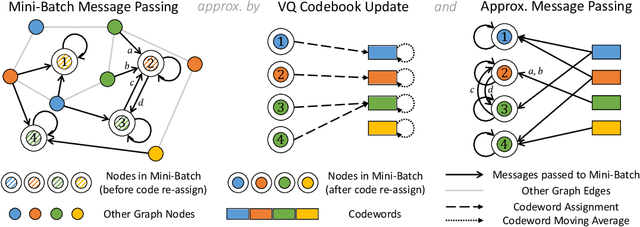

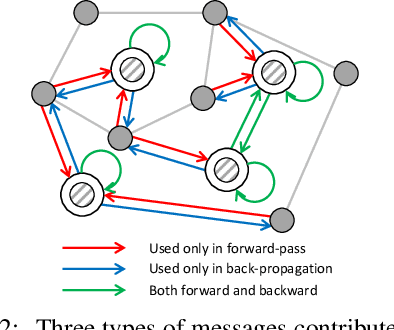

Abstract:Most state-of-the-art Graph Neural Networks (GNNs) can be defined as a form of graph convolution which can be realized by message passing between direct neighbors or beyond. To scale such GNNs to large graphs, various neighbor-, layer-, or subgraph-sampling techniques are proposed to alleviate the "neighbor explosion" problem by considering only a small subset of messages passed to the nodes in a mini-batch. However, sampling-based methods are difficult to apply to GNNs that utilize many-hops-away or global context each layer, show unstable performance for different tasks and datasets, and do not speed up model inference. We propose a principled and fundamentally different approach, VQ-GNN, a universal framework to scale up any convolution-based GNNs using Vector Quantization (VQ) without compromising the performance. In contrast to sampling-based techniques, our approach can effectively preserve all the messages passed to a mini-batch of nodes by learning and updating a small number of quantized reference vectors of global node representations, using VQ within each GNN layer. Our framework avoids the "neighbor explosion" problem of GNNs using quantized representations combined with a low-rank version of the graph convolution matrix. We show that such a compact low-rank version of the gigantic convolution matrix is sufficient both theoretically and experimentally. In company with VQ, we design a novel approximated message passing algorithm and a nontrivial back-propagation rule for our framework. Experiments on various types of GNN backbones demonstrate the scalability and competitive performance of our framework on large-graph node classification and link prediction benchmarks.
Insta-RS: Instance-wise Randomized Smoothing for Improved Robustness and Accuracy
Mar 21, 2021



Abstract:Randomized smoothing (RS) is an effective and scalable technique for constructing neural network classifiers that are certifiably robust to adversarial perturbations. Most RS works focus on training a good base model that boosts the certified robustness of the smoothed model. However, existing RS techniques treat every data point the same, i.e., the variance of the Gaussian noise used to form the smoothed model is preset and universal for all training and test data. This preset and universal Gaussian noise variance is suboptimal since different data points have different margins and the local properties of the base model vary across the input examples. In this paper, we examine the impact of customized handling of examples and propose Instance-wise Randomized Smoothing (Insta-RS) -- a multiple-start search algorithm that assigns customized Gaussian variances to test examples. We also design Insta-RS Train -- a novel two-stage training algorithm that adaptively adjusts and customizes the noise level of each training example for training a base model that boosts the certified robustness of the instance-wise Gaussian smoothed model. Through extensive experiments on CIFAR-10 and ImageNet, we show that our method significantly enhances the average certified radius (ACR) as well as the clean data accuracy compared to existing state-of-the-art provably robust classifiers.
GradInit: Learning to Initialize Neural Networks for Stable and Efficient Training
Feb 16, 2021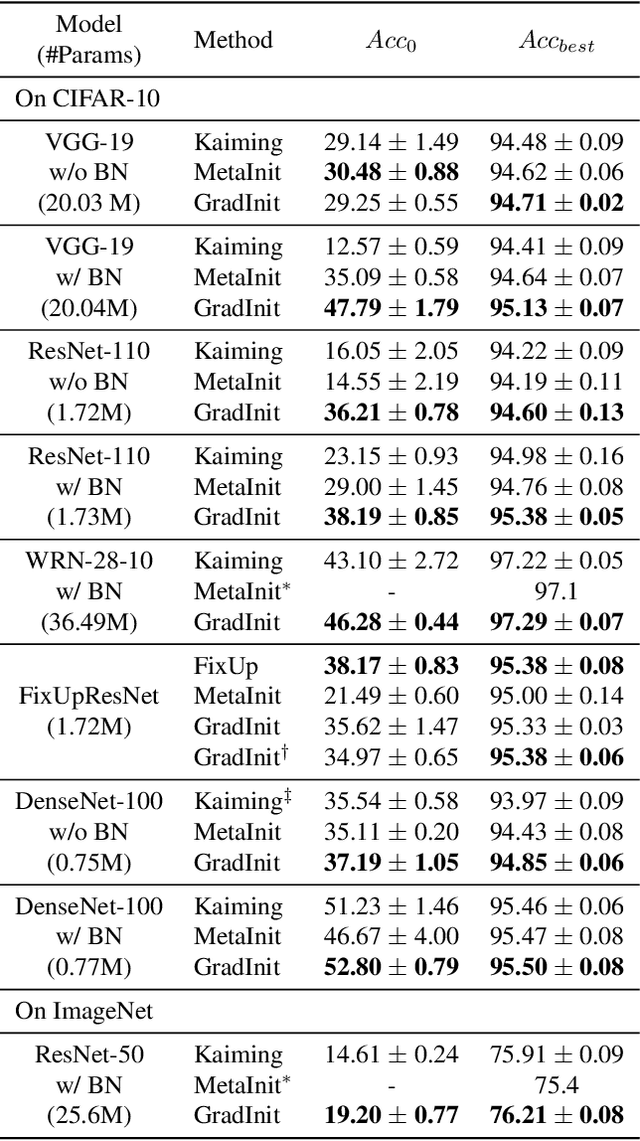


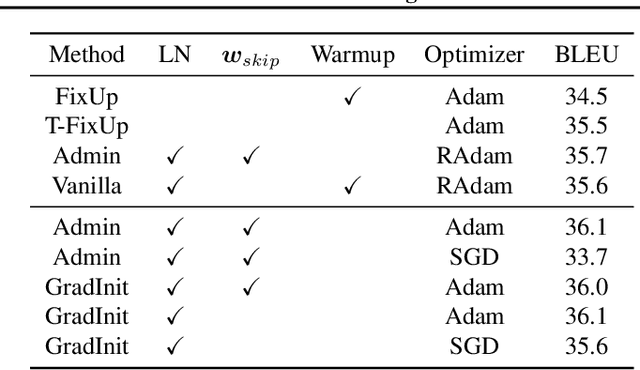
Abstract:Changes in neural architectures have fostered significant breakthroughs in language modeling and computer vision. Unfortunately, novel architectures often require re-thinking the choice of hyperparameters (e.g., learning rate, warmup schedule, and momentum coefficients) to maintain stability of the optimizer. This optimizer instability is often the result of poor parameter initialization, and can be avoided by architecture-specific initialization schemes. In this paper, we present GradInit, an automated and architecture agnostic method for initializing neural networks. GradInit is based on a simple heuristic; the variance of each network layer is adjusted so that a single step of SGD or Adam results in the smallest possible loss value. This adjustment is done by introducing a scalar multiplier variable in front of each parameter block, and then optimizing these variables using a simple numerical scheme. GradInit accelerates the convergence and test performance of many convolutional architectures, both with or without skip connections, and even without normalization layers. It also enables training the original Post-LN Transformer for machine translation without learning rate warmup under a wide range of learning rates and momentum coefficients. Code is available at https://github.com/zhuchen03/gradinit.
 Add to Chrome
Add to Chrome Add to Firefox
Add to Firefox Add to Edge
Add to Edge